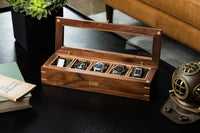Much like the A-2, M-65, and N-1, the MA-1 flight jacket has transcended its military origins to become a celebrated menswear staple. Spotted on big city streets the world over, its puffy nylon silhouette has been synonymous with youth culture for decades, though its design — which evolved from heavy leather and cotton ancestors — stems from a strictly utilitarian remit.

Brig. Gen William H. Best Jr. meets two pilots in MA-2 jackets, the MA-1's successor. - (Image by Heddels)
During the Second World War, leather flight jackets were the norm for American air crews operating in the European and Pacific theaters. These jackets slowly gave way to cotton variants, such as the B-10, in 1943 — though many pilots and crew continued to wear their issued leather A-2s (and similar models.) The B-10 represented a big change, doing away with the leather body and replacing it with a three-ply cotton shell while adding button-down patch pockets, an alpaca lining, worsted wool knit cuffs, and a mouton collar.

B-15 flight jacket - (Image by Heddels)
This jacket was itself replaced in 1943 by the B-15, which added a zippered pocket with pen slots on the sleeve, slash pockets on the front, and a nylon attachment to keep the pilot’s air hose in place. While first-gen B-15s were produced from a cotton-rayon blend, later models were manufactured from nylon, marking the first instance of a nylon flight jacket being used by U.S. armed forces.
Toward the end of the War, jet aircraft came into being, replacing their piston-driven brethren and adding the promise of tremendous speed and evasiveness. The cockpit would no longer be freezing and loud beyond all comprehension — which led to the development of heavy shearling bomber jackets during the 1940s — but would still require a comfortable, warm flight garment for high-flying pilots. Thus, in 1950, the B-15 gave way to the new MA-1 — a radical departure from previous models that has remained part of the military and sartorial zeitgeist for over 70 years.

L-2 and MA-1 flight jackets. Notice the lack of epaulettes on the MA-1. Image via Jet Pilots Overseas. - (Image by Heddels)
The MA-1, with its short, knit collar, bright orange lining (for signaling rescue crews) and nylon shell allowed for quick ingress and egress from the newer, more cramped cockpits of the Jet Age. Issued to United States Air Force and U.S. Navy pilots — in sage green and midnight blue, respectively — it featured a polyester interlining, a zipper closure that allowed for reversible usage, a sleeve pocket with pen slots, knit sleeve cuffs, and snap-down side pockets.

MA-1 MOD Bomber Jacket - (Image by Alpha Industries)
Alpha Industries, well known even today for its MA-1 variants, took up the manufacturing mantle in 1961, winning the U.S. military contract to manufacture the jacket. Sensing the garment’s popularity, it began producing modified versions for civilian use, which were quickly adopted by myriad counterculture movements: skinheads, mods, punks, and artists all wore the MA-1 — in different colors — and made it their own. Indeed, the jacket is still a popular feature of big city life in places like New York and Berlin, and can be had for cheap at surplus stores, workwear retailers, and high-end clothiers (whose modified versions sell for hundreds of dollars or more). Though no longer issued to U.S. flight crews, versions are still in use by allied militaries, including in Israel and across Southeast Asia.

Padded bomber jacket in technical cotton - (Image by Loewe)
To cop your own MA-1, check out Alpha Industries’ current-gen model ($200), which is available in more sizes and colors than the Omega Seamaster. If you’d like something a bit higher touch, there’s this Japanese-made version from SACAI ($835) that adds an inverted pleat at the reverse. Finally, if you’re ready to truly go ham, check out this padded, ultra-chic take made from water-repellant cotton ($2,750) from Loewe that pairs the jacket down to its bare essence — and adds piles of designer-approved clout.













